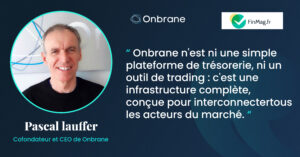Presentation of the speaker
Introduce yourself in a few words / what is your background?
Jim Shea, 22 year Goldman veteran, traded fixed income securities lending and non-fin USCP, enjoys playing music and cycling and skiing.
Can you tell us about an event that particularly marked you in your career?
My first experience trading CP was Sep 12, 2001. I was one of the only people who made it into the office that day and was trading different products at that point but we got calls from CP issuers who needed cash.
As the CP Traders were unable to make it into work that day I helped work the phones to intermediate between the Issuers and CP traders to ensure liquidity was provided to issuers and investors…
Similarly, after the 2008 GFC, we were able to provide liquidity to those who needed it (though cost had increased and maturities had shortened). Both of these experiences impressed upon me the resilience and importance of the CP market to help keep the economy going during periods of extreme stress.
The life of a USCP Dealer
As a USCP Dealer, what was a typical day like for you?
We would arrive on the desk between 6-630am and, after checking the news for market moving events, would start sending out indicative prices across the curve. Starting about 7am we would begin to receive issuance instructions.
Active trading continued until about 11-12pm after which it was cleaning up the morning – thinking about what did and didn’t work – dealing with settlement issues and preparing for tomorrow. Note that we were glued to our seats during the active trading part of the day given the pace of new orders coming in and trading activity.
What were the difficulties you faced as a Dealer?
Pain points were the manual aspects of receiving issuance instructions via multiple channels (including email, phone, bloomberg), manually entering these orders into our front end system for investors to see, following up with confirmation emails.
Errors, which occurred from time to time given the manual nature of order entry, were very time consuming to correct/fix for the trading desk, Ops, the IPA and the Issuer.
How important do you think the intermediaries are? should the market be disintermediated?
I think intermediaries are necessary for a liquid, functioning market for two reasons: first, dealers are in touch with a broad range of investors and therefore typically have the broadest range of liquidity options available to offer Issuers, resulting in greater price competition, etc.
Additionally, in times of stress dealers are able to employ their own balance sheet to provide liquidity to both issuers and investors trading in the secondary market.
Second, most non-financial issuers would need to make a significant investment in personnel and technology to bring KYC, counterparty and credit risk management in-house in order to engage directly with investors . While it’s certainly possible, and makes sense for some issuers, I believe most issuers will continue to transact through dealers for the foreseeable future.
The USCP market
Can you present the USCP market and its main characteristics?
The USCP is part of the critical infrastructure providing short term liquidity to investment grade (highly rated) financial and non-financial borrowers in a low cost, highly reliable and (once set up) on demand manner.
Typical flow is Issuers request funds for a specified period of time – typically overnight through one year – from a dealer (acting as intermediary), and the dealer helps determine demand from the institutional investor community (predominantly comprised of money market funds, asset managers, corporations, pensions, and insurance companies) and matches the borrower and lender to achieve the optimal interest rate and maturity/borrowing tenor for both parties.
Upon maturity, the borrower repays the lender after either receiving funds they were owed from another source or re-borrowing.
The USCP market in the future
How do you think the market should evolve? How do you think it will evolve?
The CP market lags behind every other financial instrument I’ve been involved with in terms of investment in trading and infrastructure, likely due the highly commoditized low margin nature of the product.
I think the market is highly overdue for technology innovation to make the market more efficient, more accurate and ultimately with reduced costs for all players using common, efficient infrastructure rather than layer upon layer of band-aids unique to each player.
What are the primary benefits of digital CP issuance for a dealer?
Accuracy/error reduction, compliance, automation, contingency planning, audit trail, analytics/transparency.
How should the roles of the existing actors (Dealer, IPA, Clearer) look like in this digitalization?
Each participant will play the same role but communication and processing will be more accurate and efficient.
Opinion on Onbrane
How would Onbrane have helped you in your day to day activity?
Onbrane would have helped us to gain market share and profitability in a few ways. First, through greater efficiency and accuracy on plain vanilla trading, we would have more time to focus on the bespoke trades that are often more difficult to execute but can be more valuable both in terms of profit and in terms of providing better service to clients.
For example, trying to match a Tier 2 issuer looking for a specific maturity nine months out (not an active part of the Tier 2 market) with an investor and then finding a mutually agreeable level. Second, as Onbrane gains traction amongst investors, sources of liquidity will expand.
Of course dealers will still need to establish a formal relationship with investors, but the ability to see who is out there and easily connect with them to start the conversation will ultimately result in greater value for all parties.
Finally, greater focus on value-add trades alongside an expanding pool of liquidity will result in greater market share… which is one of the most important metrics by which success in this business is measured.
How would you describe Onbrane?
Bringing CP (and ultimately other debt products) into the 21st century by making the market more efficient, accurate, reliable and transparent.
How does it feel to collaborate with French nerds?
I’m not convinced I’m not the nerd in this conversation! But seriously, it’s been an eye opening and educational experience for me both learning about Onbrane as a company as well as being super impressed with how engaged and reactive the Onbrane team is to feedback and coming up with new, innovative solutions to roadblocks.
The team is truly creating the platform with – and for – the users… a unique and warmly welcomed business model. I didn’t know it could be like this!
In your opinion, how will Onbrane look in 5 years?
The CP market is very slow to change/adapt but I believe Onbrane will have achieved meaningful penetration into global CP markets and be on a continued growth trajectory.
Additionally, Onbrane will likely have expanded into additional debt products, gradually creeping further out the curve. Finally, I will be surprised if the industry has not begun to embrace the Onbrane vision of blockchain underlying the CP and broader debt market infrastructure.
To finish with the most important question: which French wine do you prefer?
As my uncle is in the business, I confess to mostly drinking a full bodied Pinot Noir from Willamette Valley, Oregon that bears my family name. However, when I’m able to spurge for the good stuff, I typically default to Bordeaux.






